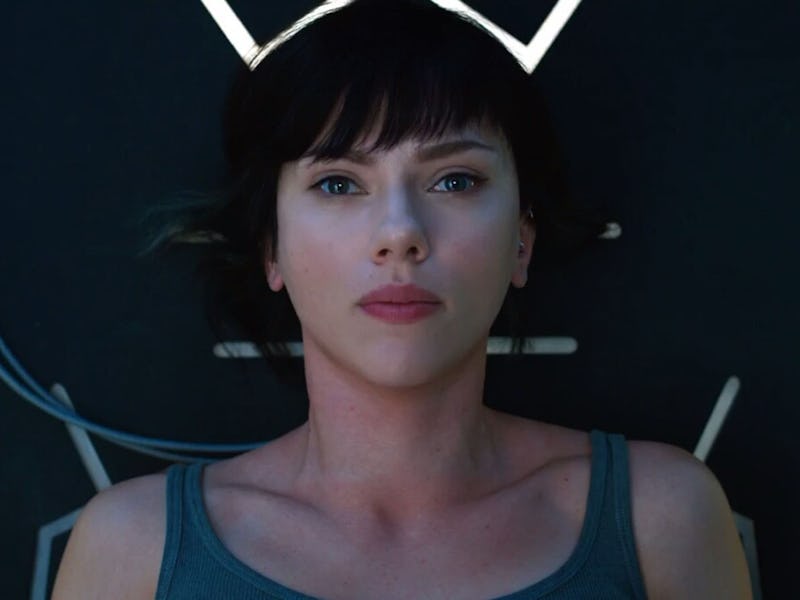All the Major Changes to 'Ghost in the Shell' From the Manga
For one, there's a lot less sex.

The American adaptation of Ghost in the Shell is just that: an adaptation. It takes the essence, the characters, and a few of the themes of the original famed manga by Masamune Shirow and recreates them into a feature-length film for the big screen. So, while a lot of the film stays true to the source material, a lot of big things are changed for the sake of levity, storytelling, originality, or maybe just because.
The characters are pretty much the same. Despite accusations of whitewashing over Scarlett Johansson’s casting as the lead character, the Major, the big names are still there. The Major’s faithful sidekick, Batou, is still strutting about and playing big brother for the rest of his team, the villain is still a bio-hacking nightmare, and Daisuke Aramaki, “old ape,” is still the chief executive director of Public Security Section 9.
Here are the major changes made from the manga and anime for Ghost in the Shell.
This post contains spoilers for Paramount Pictures’s Ghost in the Shell.
Corporations Are a Bigger Concern Than the Government
It turns out that the big bad in Ghost in the Shell is Hanka Precision Instruments. And while Hanka definitely plays a large role in the original manga and anime of the same name, manufacturing most of the A.I. robots, it’s not such a prominent villain. The new American adaptation turns Hanka into a full-blown aggressor and cuts back on the theme of government oversight and power.
Dr. Ouelet Appears Seemingly Out of Thin Air
Okay, so Dr. Ouelet doesn’t exist in the manga or anime. The Major doesn’t have some emotional, Frankenstein-esque relationship with a tortured creator who talks her down from panicking over her identity. And she definitely doesn’t have a person who gives her the key to her old life so she can reunite with her mom. Maybe that’s why the film’s creators were so comfortable with killing her off.
The Whole Thing Is a Lot Less Sexual
Despite the implied sex scene between the Major and a human prostitute, there is a severe lack of sexuality to the entire film. While that’s probably in order to fit in as much action as possible, the vibe is very different from the original source material. In the manga, the Major is an openly sexual character, taking on several relationships throughout the series and winking slyly at people on the regular.
Section 9 Doesn’t Have Its Tachikomas
In maybe one of the saddest transitions away from the manga and anime, the members don’t have their Tachikomas. In fact, the closest thing to them in the film is the spider-like tank controlled by Cutter at the end of the movie that Major tears herself apart to defeat. Tachikomas, for those missing out, are multi-legged, hive-minded combat vehicles enabled with artificial intelligence, each with a very distinct personality. If anything, Ghost in the Shell is missing out on a lot of humor because of their absence.
The Villain, Kuze, Is a Mash-Up of Several Villains
The tragic Kuze in Ghost in the Shell isn’t so much an individual character as he is a mix of a couple different characters. He takes his name from Hideo Kuze of Ghost in the Shell: Stand Alone Complex, who’s a full cyborg with an unmoving face and is one of the members of the terrorist group Individual Eleven.
The other half of movie-Kuze’s identity stems from the initial Ghost in the Shell manga in the form of “The Puppeteer,” otherwise known as the “Puppet Master.” Completely inhuman, the Puppet Master is an experiment-gone-wrong of Section 6 of Public Security. The artificial intelligence, originally called Project 2501, is created for the Japanese Ministry of Foreign Affairs to secretly manipulate politics and the intelligence world. Eventually, Project 2501 becomes sentient and goes completely rogue, invading cyber brains and creating chaos wherever he goes.
We See Batou Get His Cyborg Eyes
Ghost in the Shell opens with a human-eyed Batou. The character’s defining physical characteristic, his inhuman eyes, is non-existent for a good period of the film, and it’s only after an explosion that he gets his new eyes installed. The Major saves him from the majority of the blast and questions Batou about why he’d choose such non-human-looking eyes. His response is that they’re better for the job, further normalizing their world’s casual behavior over cybernetic enhancements.
Audiences Meet the Major’s Mom
In possibly the biggest and most shocking change for the film, the Major ends up meeting her mother after being given the address of her childhood home by Dr. Ouelet. The meeting is a painfully awkward scene full of unspoken dialogue, and audiences are meant to imply that, yes, the grieving woman is the Major’s mother, but it’s never actually said aloud.
Ghost in the Shell is now playing in theaters.